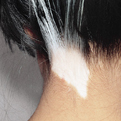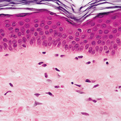Vitiligo
General Information
Vitiligo is a condition resulting from loss of pigmentation in the skin, producing white patches. The affected areas commonly seen are the face, lips, hands, arms, legs and genital areas. About half the individuals that develop vitiligo will develop it before they are 20 years old. Melanin is the pigment that determines the color of skin, hair and eyes. Melanin is produced in cells called melanocytes. Vitiligo is caused when the melanocytes die or cannot form melanin. The affected areas go through a process where a rapid loss of pigmentation occurs, the process may cycle to times that no pigmentation is lost then the loss occurs again. This cycle may continue indefinitely. Treatment is based on the number of white patches an individual has and the location of them. Current treatments available include medical, surgical, and adjunctive therapies (therapies that can be used along with surgical or medical treatments). Systemic phototherapy induces cosmetically satisfactory repigmentation in up to 70% of early or localized cases.
Epidemiology
0.5 to 2% of the population
Etiology
Melanocytes destroyed in skin
Pathogenesis
Progressive disorder in which some or all of the melanocytes in the interfollicular epidermis, and occasionally those in the hair follicles, are selectively destroyed.
Clinical
Focal pattern – depigmentation of skin in one or a few areas; Segmental pattern – depigmentation on one side of body; Generalized pattern – Occurs symmetrically on both sides of body.
Histology
Sparse superficial perivascular infiltrates of lymphocytes and with lymphocytes that also are present in the epidermis in company with slight spongiosis.
Bibliography
1. “Vitiligo” (Online). April 2005. http://www.emedicine.com/derm/TOPIC453.HTM (visited: April 5, 2008) 2. “Vitiligo” (Online). http://www.aad.org/public/publications/pamphlets/common_vitilgo.html (visited: April 5, 2008)
Download PDF
![]() Vitiligo
Vitiligo


